height adjustment Seat Exeo 2010 Owner's manual
[x] Cancel search | Manufacturer: SEAT, Model Year: 2010, Model line: Exeo, Model: Seat Exeo 2010Pages: 319, PDF Size: 9.64 MB
Page 15 of 319
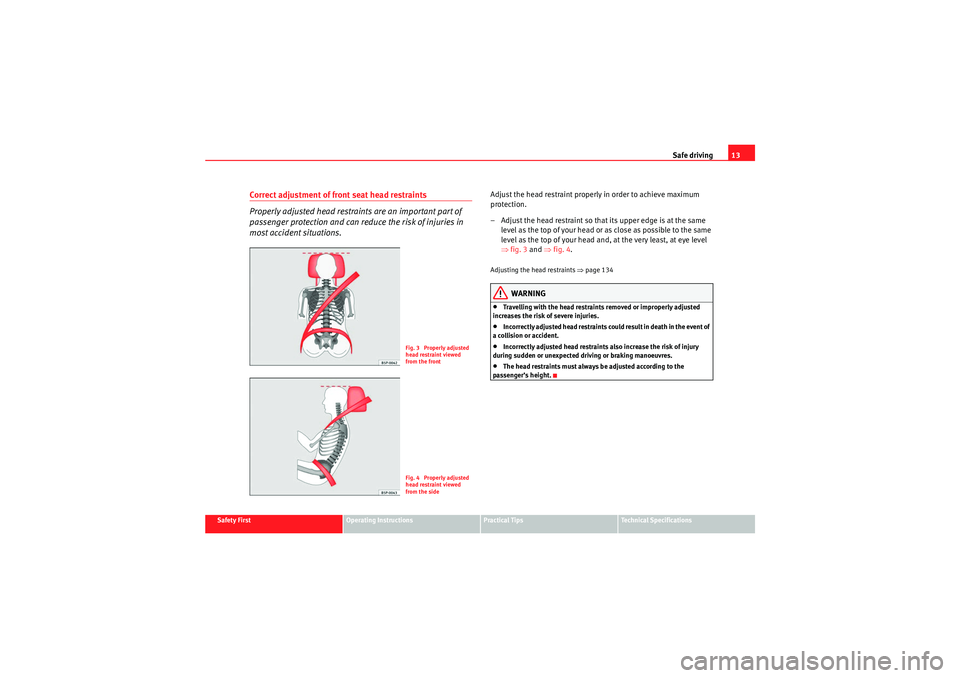
Safe driving13
Safety First
Operating Instructions
Practical Tips
Technical Specifications
Correct adjustment of front seat head restraints
Properly adjusted head restraints are an important part of
passenger protection and can reduce the risk of injuries in
most accident situations.
Adjust the head restraint properly in order to achieve maximum
protection.
– Adjust the head restraint so that its upper edge is at the same
level as the top of your head or as close as possible to the same
level as the top of your head and, at the very least, at eye level
⇒fig. 3 and ⇒fig. 4 .Adjusting the head restraints ⇒page 134
WARNING
•Travelling with the head restraints removed or improperly adjusted
increases the risk of severe injuries.•Incorrectly adjusted head restraints could result in death in the event of
a collision or accident.•Incorrectly adjusted head restraints also increase the risk of injury
during sudden or unexpected driving or braking manoeuvres.•The head restraints must always be adjusted according to the
passenger’s height.
Fig. 3 Properly adjusted
head restraint viewed
from the frontFig. 4 Properly adjusted
head restraint viewed
from the side
exeo_EN.book Seite 13 Montag, 30. August 2010 4:45 16
Page 26 of 319
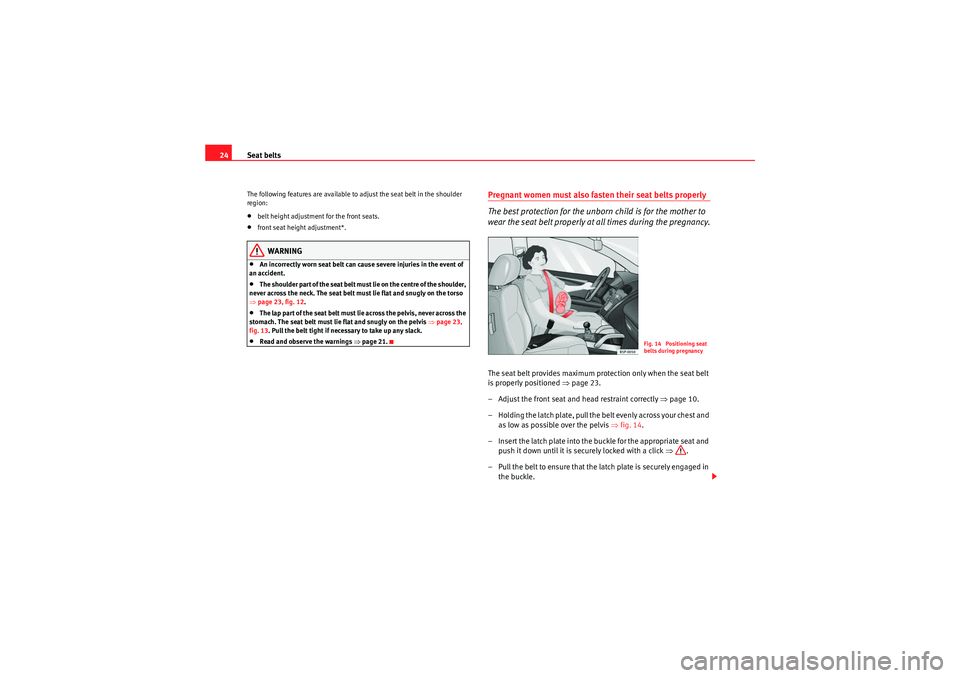
Seat belts
24The following features are available to adjust the seat belt in the shoulder
region:•belt height adjustment for the front seats.•front seat height adjustment*.WARNING
•An incorrectly worn seat belt can cause severe injuries in the event of
an accident.•The shoulder part of the seat belt must lie on the centre of the shoulder,
never across the neck. The seat belt must lie flat and snugly on the torso
⇒ page 23, fig. 12 .•The lap par t of the seat belt must lie across the pelvis, never across the
stomach. The seat belt must lie flat and snugly on the pelvis ⇒page 23,
fig. 13. Pull the belt tight if necessary to take up any slack.•Read and observe the warnings ⇒page 21.
Pregnant women must also fasten their seat belts properly
The best protection for the unborn child is for the mother to
wear the seat belt properly at all times during the pregnancy.The seat belt provides maximum protection only when the seat belt
is properly positioned ⇒page 23.
– Adjust the front seat and head restraint correctly ⇒page 10.
– Holding the latch plate, pull the belt evenly across your chest and as low as possible over the pelvis ⇒fig. 14 .
– Insert the latch plate into the buckle for the appropriate seat and push it down until it is securely locked with a click ⇒.
– Pull the belt to ensure that the latch plate is securely engaged in the buckle.
Fig. 14 Positioning seat
belts during pregnancy
exeo_EN.book Seite 24 Montag, 30. August 2010 4:45 16
Page 27 of 319

Seat belts25
Safety First
Operating Instructions
Practical Tips
Technical Specifications
WARNING
•An incorrectly worn seat belt can cause severe injuries in the event of
an accident.•For pregnant women, the lap part of the seat belt must lie as low as
possible over the pelvis, never across the stomach, and always lie flat so
that no pressure is exerted on the abdomen.•Read and observe the warnings ⇒page 21.
Seat belt release
The seat belt must not be unfastened until the vehicle has
come to a standstill.– Press the red button on the belt buckle ⇒fig. 15 . The latch plate
is released and springs out ⇒ . – Guide the belt back by hand so that it rolls up easily and the trim
is not damaged
WARNING
Never unbuckle a seat belt while the vehicle is in motion. If you do, you
increase the risk of sustaining severe or fatal injuries.Seat belt height adjustment
Seat belt height adjusters can be used to adjust the height of
the shoulder area of the seat belt.The belt height adjuster can be lowered by keeping the button
pressed down at the same time.
– Press button ⇒fig. 16 to adjust the belt height.
Fig. 15 Removing latch
plate from buckle
Fig. 16 Belt height
adjuster
A1
exeo_EN.book Seite 25 Montag, 30. August 2010 4:45 16
Page 49 of 319
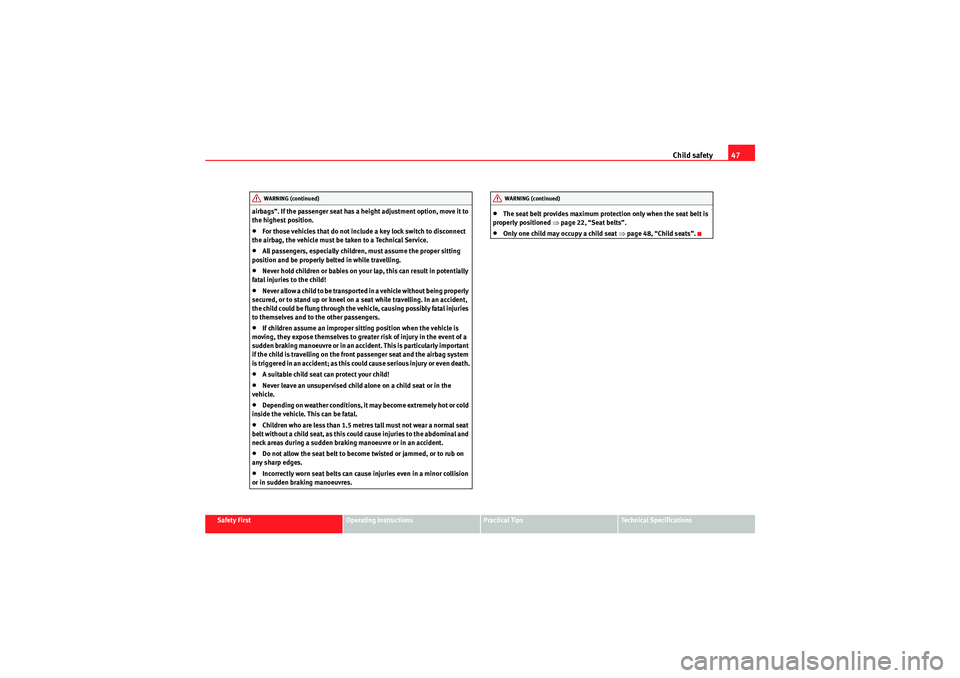
Child safety47
Safety First
Operating Instructions
Practical Tips
Technical Specifications
airbags”. If the passenger seat has a height adjustment option, move it to
the highest position.
•For those vehicles that do not include a key lock switch to disconnect
the airbag, the vehicle must be taken to a Technical Service.•All passengers, especially children, must assume the proper sitting
position and be properly belted in while travelling.•Never hold children or babies on your lap, this can result in potentially
fatal injuries to the child!•Never allow a child to be transported in a vehicle without being properly
secured, or to stand up or kneel on a seat while travelling. In an accident,
the child could be flung through the vehicle, causing possibly fatal injuries
to themselves and to the other passengers.•If children assume an improper sitting position when the vehicle is
moving, they expose themselves to greater risk of injury in the event of a
sudden braking manoeuvre or in an accident. This is particularly important
if the child is travelling on the front passenger seat and the airbag system
is t riggered in an accid ent ; as this could caus e s erious inj ur y or eve n deat h.•A suitable child seat can protect your child!•Never leave an unsupervised child alone on a child seat or in the
vehicle.•Depending on weather conditions, it may become extremely hot or cold
inside the vehicle. This can be fatal.•Children who are less than 1.5 metres tall must not wear a normal seat
belt without a child seat, as this could cause injuries to the abdominal and
neck areas during a sudden braking manoeuvre or in an accident.•Do not allow the seat belt to become twisted or jammed, or to rub on
any sharp edges.•Incorrectly worn seat belts can cause injuries even in a minor collision
or in sudden braking manoeuvres.
•The seat belt provides maximum protection only when the seat belt is
properly positioned ⇒page 22, “Seat belts”.•Only one child may occupy a child seat ⇒page 48, “Child seats”.
WARNING (continued)
WARNING (continued)
exeo_EN.book Seite 47 Montag, 30. August 2010 4:45 16
Page 136 of 319

Seats and storage compartments
134Seats and storage compartmentsManual adjustment of the front seatsSeat adjuster controls
There are several seat adjustment functions for your conven-
ienceS o m e o f t h e e q u i p m e n t l is t e d is o n l y f i t t e d o n ce r ta i n m o d e l s o r is a n o p t i o na l
extra.
Control switches
Moving the seat backwards or forwards
Raising/lowering the seat
Adjusting the backrest angle
Adjusting the lumbar support
Moving the seats forwards and backwards– Lift the lever ⇒fig. 105 and move the seat to the desired
position.
– Then release the lever and move the seat further until the catch engages.
WARNING
The driver seat must only be moved forwards and backwards when the
vehicle is at a standstill. Failure to do so could result in an accident.Adjusting the seat height*Raising the seat
– Pull the lever ⇒ fig. 105 up repeatedly until the seat is in the
desired position.
Lowering the seat
– Press the lever down repeatedly until the seat is in the desired position.
WARNING
•The height of the driver seat must not be adjusted while driving. Failure
to do so could result in an accident.
Fig. 105 Adjuster
controls on driver seat
A1A2A3A4
A1
A1
A2A2
exeo_EN.book Seite 134 Montag, 30. August 2010 4:45 16
Page 137 of 319
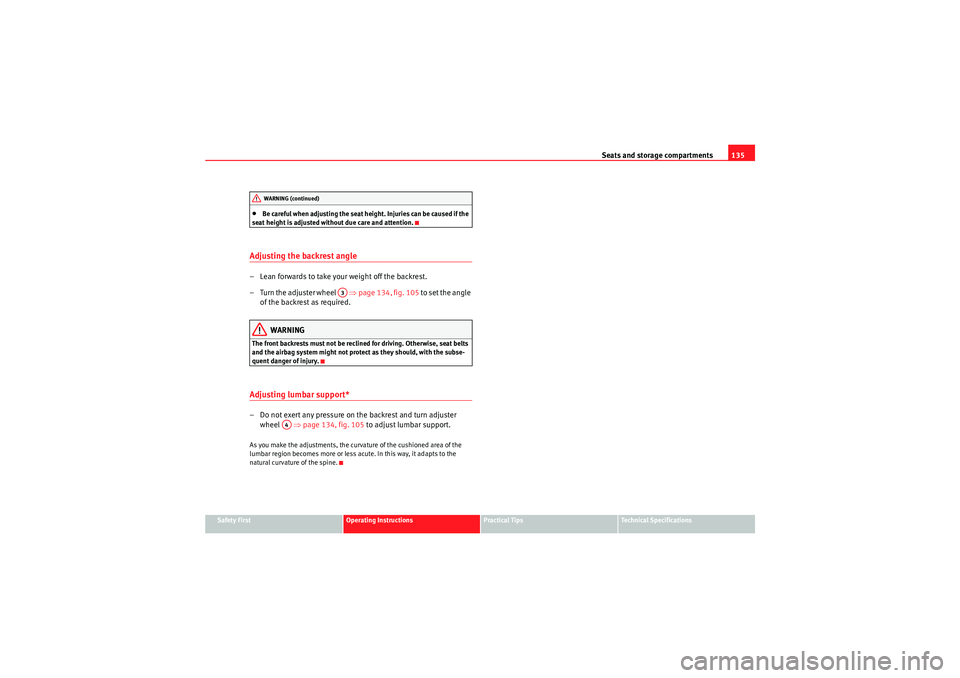
Seats and storage compartments135
Safety First
Operating Instructions
Practical Tips
Technical Specifications
•Be careful when adjusting the seat height. Injuries can be caused if the
seat height is adjusted without due care and attention.
Adjusting the backrest angle– Lean forwards to take your weight off the backrest.
– Turn the adjuster wheel ⇒ page 134, fig. 105 to set the angle
of the backrest as required.
WARNING
The front backrests must not be reclined for driving. Otherwise, seat belts
and the airbag system might not protect as they should, with the subse-
quent danger of injury.Adjusting lumbar support*– Do not exert any pressure on the backrest and turn adjuster wheel ⇒page 134, fig. 105 to adjust lumbar support.As you make the adjustments, the curvature of the cushioned area of the
lumbar region becomes more or less acute. In this way, it adapts to the
natural curvature of the spine.
WARNING (continued)
A3
A4
exeo_EN.book Seite 135 Montag, 30. August 2010 4:45 16
Page 139 of 319
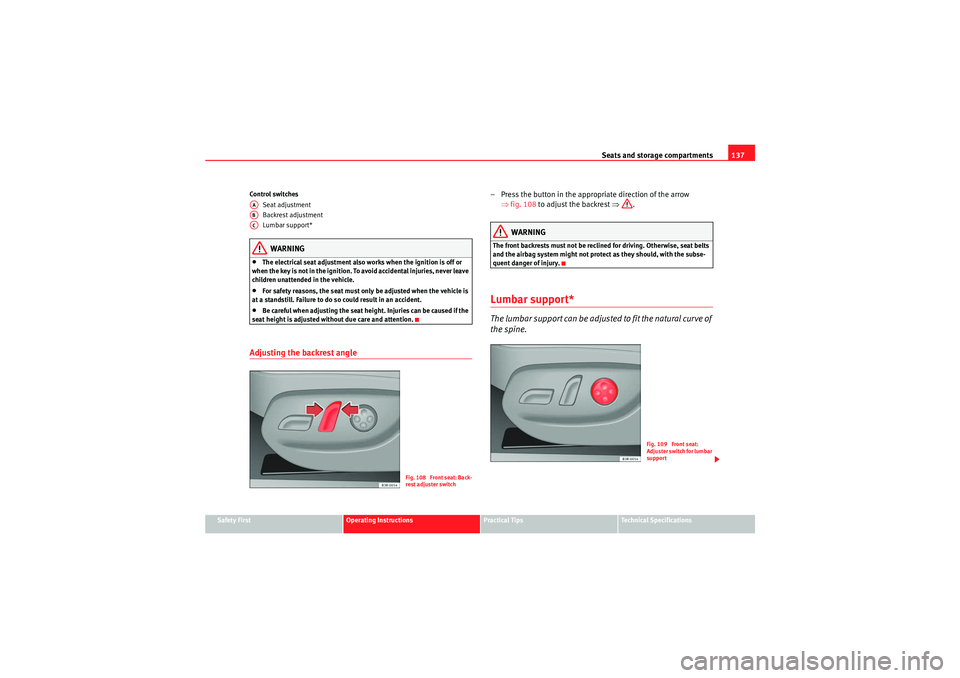
Seats and storage compartments137
Safety First
Operating Instructions
Practical Tips
Technical Specifications
Control switches
Seat adjustment
Backrest adjustment
Lumbar support*
WARNING
•The electrical seat adjustment also works when the ignition is off or
when the key is not in the ignition. To avoid accidental injuries, never leave
children unattended in the vehicle.•For safety reasons, the seat must only be adjusted when the vehicle is
at a standstill. Failure to do so could result in an accident.•Be careful when adjusting the seat height. Injuries can be caused if the
seat height is adjusted without due care and attention.
Adjusting the backrest angle
– Press the button in the appr opriate direction of the arrow
⇒ fig. 108 to adjust the backrest ⇒.
WARNING
The front backrests must not be reclined for driving. Otherwise, seat belts
and the airbag system might not protect as they should, with the subse-
quent danger of injury.Lumbar support*The lumbar support can be adjusted to fit the natural curve of
the spine.
AAABAC
Fig. 108 Front seat: Back-
rest adjuster switch
Fig. 109 Front seat:
Adjuster switch for lumbar
support
exeo_EN.book Seite 137 Montag, 30. August 2010 4:45 16
Page 315 of 319
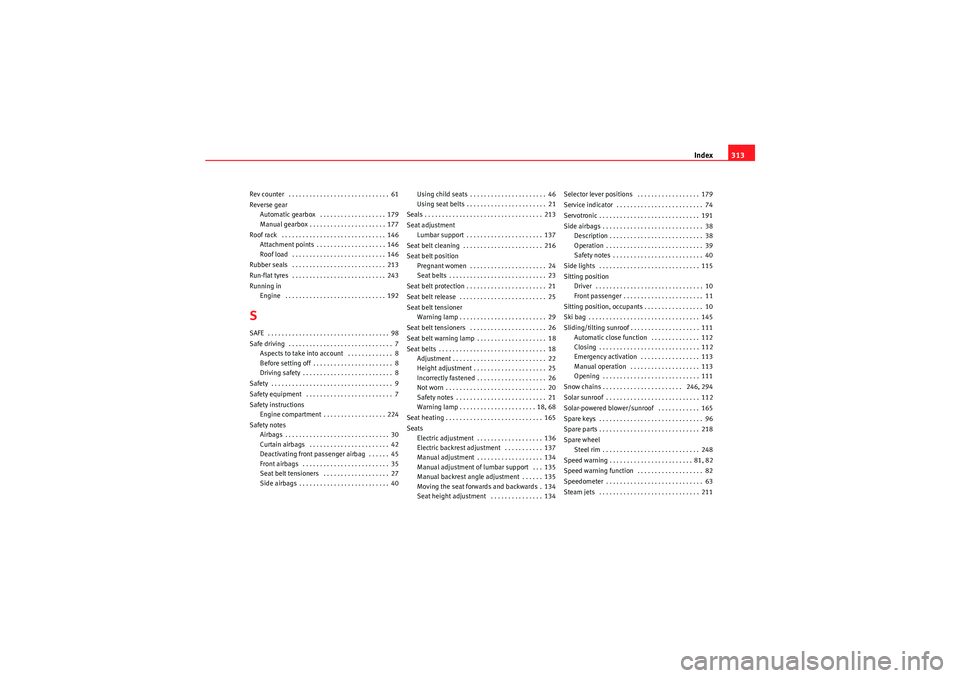
Index313
Rev counter . . . . . . . . . . . . . . . . . . . . . . . . . . . . . 61
Reverse gear
Automatic gearbox . . . . . . . . . . . . . . . . . . . 179
Manual gearbox . . . . . . . . . . . . . . . . . . . . . . 177
Roof rack . . . . . . . . . . . . . . . . . . . . . . . . . . . . . . 146 Attachment points . . . . . . . . . . . . . . . . . . . . 146
Roof load . . . . . . . . . . . . . . . . . . . . . . . . . . . 146
Rubber seals . . . . . . . . . . . . . . . . . . . . . . . . . . . 213
Run-flat tyres . . . . . . . . . . . . . . . . . . . . . . . . . . . 243
Running in Engine . . . . . . . . . . . . . . . . . . . . . . . . . . . . . 192SSAFE . . . . . . . . . . . . . . . . . . . . . . . . . . . . . . . . . . . 98
Safe driving . . . . . . . . . . . . . . . . . . . . . . . . . . . . . . 7
Aspects to take into account . . . . . . . . . . . . . 8
Before setting off . . . . . . . . . . . . . . . . . . . . . . . 8
Driving safety . . . . . . . . . . . . . . . . . . . . . . . . . . 8
Safety . . . . . . . . . . . . . . . . . . . . . . . . . . . . . . . . . . . 9
Safety equipment . . . . . . . . . . . . . . . . . . . . . . . . . 7
Safety instructions Engine compartment . . . . . . . . . . . . . . . . . . 224
Safety notes Airbags . . . . . . . . . . . . . . . . . . . . . . . . . . . . . . 30
Curtain airbags . . . . . . . . . . . . . . . . . . . . . . . 42
Deactivating front passenger airbag . . . . . . 45
Front airbags . . . . . . . . . . . . . . . . . . . . . . . . . 35
Seat belt tensioners . . . . . . . . . . . . . . . . . . . 27
Side airbags . . . . . . . . . . . . . . . . . . . . . . . . . . 40 Using child seats . . . . . . . . . . . . . . . . . . . . . . 46
Using seat belts . . . . . . . . . . . . . . . . . . . . . . . 21
Seals . . . . . . . . . . . . . . . . . . . . . . . . . . . . . . . . . . 213
Seat adjustment Lumbar support . . . . . . . . . . . . . . . . . . . . . . 137
Seat belt cleaning . . . . . . . . . . . . . . . . . . . . . . . 216
Seat belt position Pregnant women . . . . . . . . . . . . . . . . . . . . . . 24
Seat belts . . . . . . . . . . . . . . . . . . . . . . . . . . . . 23
Seat belt protection . . . . . . . . . . . . . . . . . . . . . . . 21
Seat belt release . . . . . . . . . . . . . . . . . . . . . . . . . 25
Seat belt tensioner Warning lamp . . . . . . . . . . . . . . . . . . . . . . . . . 29
Seat belt tensioners . . . . . . . . . . . . . . . . . . . . . . 26
Seat belt warning lamp . . . . . . . . . . . . . . . . . . . . 18
Seat belts . . . . . . . . . . . . . . . . . . . . . . . . . . . . . . . 18 Adjustment . . . . . . . . . . . . . . . . . . . . . . . . . . . 22
Height adjustment . . . . . . . . . . . . . . . . . . . . . 25
Incorrectly fastened . . . . . . . . . . . . . . . . . . . . 26
Not worn . . . . . . . . . . . . . . . . . . . . . . . . . . . . . 20
Safety notes . . . . . . . . . . . . . . . . . . . . . . . . . . 21
Warning lamp . . . . . . . . . . . . . . . . . . . . . . 18, 68
Seat heating . . . . . . . . . . . . . . . . . . . . . . . . . . . . 165
Seats Electric adjustment . . . . . . . . . . . . . . . . . . . 136
Electric backrest adjustment . . . . . . . . . . . 137
Manual adjustment . . . . . . . . . . . . . . . . . . . 134
Manual adjustment of lumbar support . . . 135
Manual backrest angle adjustment . . . . . . 135
Moving the seat forwards and backwards . 134
Seat height adjustment . . . . . . . . . . . . . . . 134 Selector lever positions . . . . . . . . . . . . . . . . . . 179
Service indicator . . . . . . . . . . . . . . . . . . . . . . . . . 74
Servotronic . . . . . . . . . . . . . . . . . . . . . . . . . . . . . 191
Side airbags . . . . . . . . . . . . . . . . . . . . . . . . . . . . . 38
Description . . . . . . . . . . . . . . . . . . . . . . . . . . . 38
Operation . . . . . . . . . . . . . . . . . . . . . . . . . . . . 39
Safety notes . . . . . . . . . . . . . . . . . . . . . . . . . . 40
Side lights . . . . . . . . . . . . . . . . . . . . . . . . . . . . . 115
Sitting position Driver . . . . . . . . . . . . . . . . . . . . . . . . . . . . . . . 10
Front passenger . . . . . . . . . . . . . . . . . . . . . . . 11
Sitting position, occupants . . . . . . . . . . . . . . . . . 10
Ski bag . . . . . . . . . . . . . . . . . . . . . . . . . . . . . . . . 145
Sliding/tilting sunroof . . . . . . . . . . . . . . . . . . . . 111 Automatic close function . . . . . . . . . . . . . . 112
Closing . . . . . . . . . . . . . . . . . . . . . . . . . . . . . 112
Emergency activation . . . . . . . . . . . . . . . . . 113
Manual operation . . . . . . . . . . . . . . . . . . . . 113
Opening . . . . . . . . . . . . . . . . . . . . . . . . . . . . 111
Snow chains . . . . . . . . . . . . . . . . . . . . . . . 246, 294
Solar sunroof . . . . . . . . . . . . . . . . . . . . . . . . . . . 112
Solar-powered blower/sunroof . . . . . . . . . . . . 165
Spare keys . . . . . . . . . . . . . . . . . . . . . . . . . . . . . . 96
Spare parts . . . . . . . . . . . . . . . . . . . . . . . . . . . . . 218
Spare wheel Steel rim . . . . . . . . . . . . . . . . . . . . . . . . . . . . 248
Speed warning . . . . . . . . . . . . . . . . . . . . . . . . 81, 82
Speed warning function . . . . . . . . . . . . . . . . . . . 82
Speedometer . . . . . . . . . . . . . . . . . . . . . . . . . . . . 63
Steam jets . . . . . . . . . . . . . . . . . . . . . . . . . . . . . 211
exeo_EN.book Seite 313 Montag, 30. August 2010 4:45 16